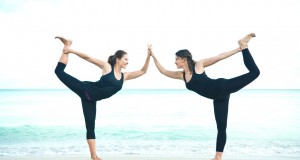Yoga - The Life-Affirming Art
The True Purpose of Yoga
Recently the New York Times ran an article about yoga wrecking your body. It detailed injuries people had suffered after doing yoga. Some of them sounded a bit extreme and all were certainly unfortunate. The two most memorable to me were a young man who sat in the lotus position until his legs gave out and a woman who hit her head trying to do wheel pose. Wheel pose is difficult at first and you do have to tuck your head – it’s so sad no one was there to tell her that – and staying in lotus for hours on end is not really healthy. Holding any pose for that long is counter-intuitive and contrary to the rhythm of the body and of life.
People do get injured in yoga class though. It’s a known fact. All yoga studios will make you sign a waiver when you first take a class saying that you are responsible for any physical problems you may encounter. I think this is wise. It encourages you to realize that you are in charge of your own body in class. Yoga is not something with which to twist your body into painful contortions, yoga is for you to learn to feel your body. To know what stretches will realign your spine. To know what movements will make you feel stronger and more vibrant.
Why You Need a Good Teacher (Especially in the Beginning)
When you are ready to try a new challenging pose, it’s great if you can ask a teacher or assistant to keep an eye on you. They can guide you if you do something that looks like it might hurt you either because you’re not in the proper alignment or because it’s just too difficult for you right now. As we all know, if something is too much for you today, you’ll probably get it one day. And if it hurts today, don’t do it. Don’t push your body into pain. Learn to tell the difference between stretching your muscles and hurting yourself.
Still, sometimes it’s not easy to know when to stop. People do get hurt even if they’re not trying to show off or push themselves. This is where a good teacher comes in. A good teacher will always warm up your muscles and sequence the practice to focus on the warmed up muscles so that you can’t hurt yourself. A good teacher will know what level to take the class to and whether the people in the class can handle more advanced (and therefore potentially painful) poses. A good teacher will often start the class by asking if anyone has any injuries or aches they want to talk about. They may ask if there are any areas of the body that are particularly tight and need work in the class.
A less experienced teacher will sometimes throw in poses that are deceptively difficult. If you’re not an experienced yogi, and don’t know yet what feels right for your body and in the practice, you may find yourself in pain the next day.
So how do you avoid inexperienced teachers? I don’t think it’s possible. There are so many new yoga teachers getting trained all the time, and so many studios in NYC and all over the world now, it’s inevitable that you will study with a less experienced teacher.
If you do get hurt, just take it easy until you feel better. Unless you have somehow suffered some kind of major crisis (and 99.9% of all yogis easily avoid that!) your body will heal itself over time.
It’s not like the teacher meant to hurt you. Young teachers love getting out there and trying their new art. They are enthusiastic, eager, passionate – all of which is great. Yet there is no substitute for the wisdom of the experienced teacher.
When you find a teacher you really like, stick with her or him. There’s nothing nicer than looking forward to a great class with a teacher you really enjoy. Learning from a master is always a rewarding life enhancement.
If you get bored with a teacher, move on. Keep yourself challenged in yoga and yoga will keep you healthy.
It is a life-affirming art and we are all the better for it, right?












